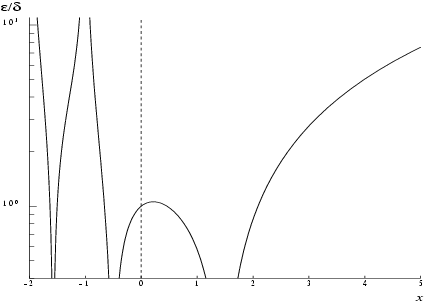s14aa returns the value of the gamma function .
 Syntax
Syntax
| C# |
|---|
public static double s14aa( double x, out int ifail ) |
| Visual Basic |
|---|
Public Shared Function s14aa ( _ x As Double, _ <OutAttribute> ByRef ifail As Integer _ ) As Double |
| Visual C++ |
|---|
public: static double s14aa( double x, [OutAttribute] int% ifail ) |
| F# |
|---|
static member s14aa : x : float * ifail : int byref -> float |
Parameters
- x
- Type: System..::..DoubleOn entry: the argument of the function.Constraint: must not be zero or a negative integer.
- ifail
- Type: System..::..Int32%On exit: unless the method detects an error or a warning has been flagged (see [Error Indicators and Warnings]).
Return Value
s14aa returns the value of the gamma function .
 Description
Description
s14aa evaluates an approximation to the gamma function . The method is based on the Chebyshev expansion:
and uses the property . If where is integral and then it follows that:
- for , ,
- for , ,
- for , .
There are four possible failures for this method:
| (i) | if is too large, there is a danger of overflow since could become too large to be represented in the machine; |
| (ii) | if is too large and negative, there is a danger of underflow; |
| (iii) | if is equal to a negative integer, would overflow since it has poles at such points; |
| (iv) | if is too near zero, there is again the danger of overflow on some machines. For small , , and on some machines there exists a range of nonzero but small values of for which is larger than the greatest representable value. |
 References
References
Abramowitz M and Stegun I A (1972) Handbook of Mathematical Functions (3rd Edition) Dover Publications
 Error Indicators and Warnings
Error Indicators and Warnings
Errors or warnings detected by the method:
- The argument is too large. On failure the method returns the approximate value of at the nearest valid argument.
- The argument is too large and negative. On failure the method returns zero.
- The argument is too close to zero. On failure the method returns the approximate value of at the nearest valid argument.
- The argument is a negative integer, at which value is infinite. On failure the method returns a large positive value.
 Accuracy
Accuracy
Let and be the relative errors in the argument and the result respectively. If is somewhat larger than the machine precision (i.e., is due to data errors etc.), then and are approximately related by:
(provided is also greater than the representation error). Here is the digamma function . Figure 1 shows the behaviour of the error amplification factor .
If is of the same order as machine precision, then rounding errors could make slightly larger than the above relation predicts.
There is clearly a severe, but unavoidable, loss of accuracy for arguments close to the poles of at negative integers. However relative accuracy is preserved near the pole at right up to the point of failure arising from the danger of overflow.
Also accuracy will necessarily be lost as becomes large since in this region
However since increases rapidly with , the method must fail due to the danger of overflow before this loss of accuracy is too great. (For example, for , the amplification factor .)
 Parallelism and Performance
Parallelism and Performance
None.
 Further Comments
Further Comments
None.
 Example
Example
This example reads values of the argument from a file, evaluates the function at each value of and prints the results.
Example program (C#): s14aae.cs
